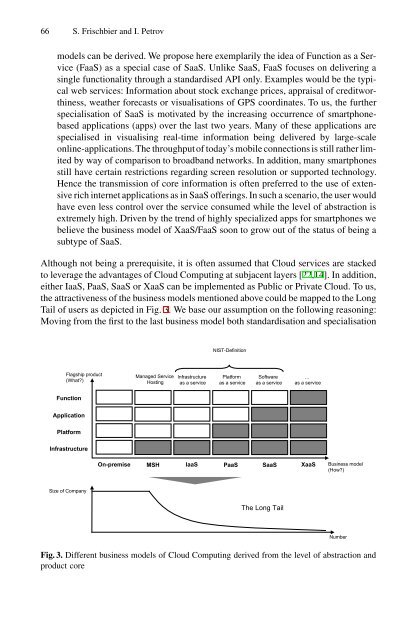Aspects of Data-Intensive Cloud Computing - DVS - Technische ...
Aspects of Data-Intensive Cloud Computing - DVS - Technische ...
Aspects of Data-Intensive Cloud Computing - DVS - Technische ...
You also want an ePaper? Increase the reach of your titles
YUMPU automatically turns print PDFs into web optimized ePapers that Google loves.
66 S. Frischbier and I. Petrov<br />
models can be derived. We propose here exemplarily the idea <strong>of</strong> Function as a Service<br />
(FaaS) as a special case <strong>of</strong> SaaS. Unlike SaaS, FaaS focuses on delivering a<br />
single functionality through a standardised API only. Examples would be the typical<br />
web services: Information about stock exchange prices, appraisal <strong>of</strong> creditworthiness,<br />
weather forecasts or visualisations <strong>of</strong> GPS coordinates. To us, the further<br />
specialisation <strong>of</strong> SaaS is motivated by the increasing occurrence <strong>of</strong> smartphonebased<br />
applications (apps) over the last two years. Many <strong>of</strong> these applications are<br />
specialised in visualising real-time information being delivered by large-scale<br />
online-applications.The throughput<strong>of</strong> today’s mobile connections is still rather limited<br />
by way <strong>of</strong> comparison to broadband networks. In addition, many smartphones<br />
still have certain restrictions regarding screen resolution or supported technology.<br />
Hence the transmission <strong>of</strong> core information is <strong>of</strong>ten preferred to the use <strong>of</strong> extensive<br />
rich internet applications as in SaaS <strong>of</strong>ferings. In such a scenario, the user would<br />
have even less control over the service consumed while the level <strong>of</strong> abstraction is<br />
extremely high. Driven by the trend <strong>of</strong> highly specialized apps for smartphones we<br />
believe the business model <strong>of</strong> XaaS/FaaS soon to grow out <strong>of</strong> the status <strong>of</strong> being a<br />
subtype <strong>of</strong> SaaS.<br />
Although not being a prerequisite, it is <strong>of</strong>ten assumed that <strong>Cloud</strong> services are stacked<br />
to leverage the advantages <strong>of</strong> <strong>Cloud</strong> <strong>Computing</strong> at subjacent layers [22,14]. In addition,<br />
either IaaS, PaaS, SaaS or XaaS can be implemented as Public or Private <strong>Cloud</strong>. To us,<br />
the attractiveness <strong>of</strong> the business models mentioned above could be mapped to the Long<br />
Tail <strong>of</strong> users as depicted in Fig. 3. We base our assumption on the following reasoning:<br />
Moving from the first to the last business model both standardisation and specialisation<br />
NIST-Definition<br />
Flagship product<br />
(What?)<br />
Managed Service<br />
Hosting<br />
Infrastructure<br />
as a service<br />
Platform<br />
as a service<br />
S<strong>of</strong>tware<br />
as a service<br />
…<br />
as a service<br />
Function<br />
Application<br />
Platform<br />
Infrastructure<br />
On-premise<br />
MSH IaaS PaaS SaaS XaaS<br />
Business model<br />
(How?)<br />
Size <strong>of</strong> Company<br />
The Long Tail<br />
Number<br />
Fig. 3. Different business models <strong>of</strong> <strong>Cloud</strong> <strong>Computing</strong> derived from the level <strong>of</strong> abstraction and<br />
product core















